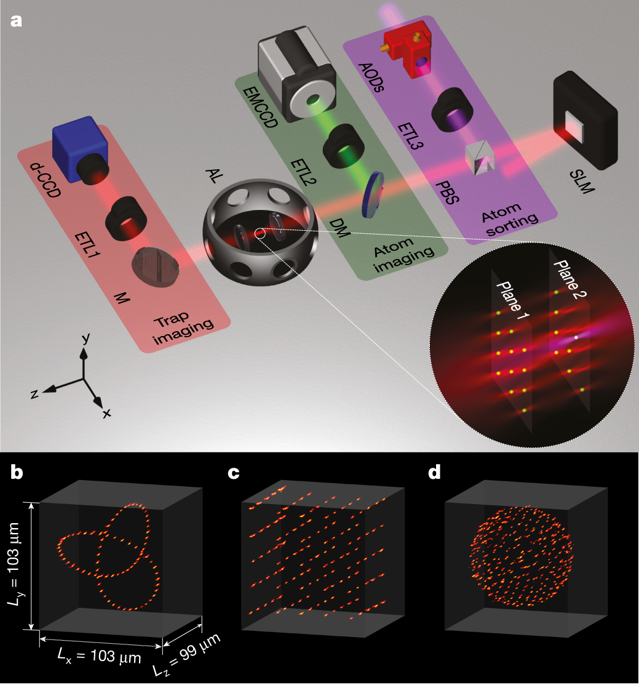Our official English website, www.x-mol.net, welcomes your
feedback! (Note: you will need to create a separate account there.)
Synthetic three-dimensional atomic structures assembled atom by atom
Nature ( IF 50.5 ) Pub Date : 2018-09-01 , DOI: 10.1038/s41586-018-0450-2 Daniel Barredo , Vincent Lienhard , Sylvain de Léséleuc , Thierry Lahaye , Antoine Browaeys
Nature ( IF 50.5 ) Pub Date : 2018-09-01 , DOI: 10.1038/s41586-018-0450-2 Daniel Barredo , Vincent Lienhard , Sylvain de Léséleuc , Thierry Lahaye , Antoine Browaeys

|
A great challenge in current quantum science and technology research is to realize artificial systems of a large number of individually controlled quantum bits for applications in quantum computing and quantum simulation. Many experimental platforms are being explored, including solid-state systems, such as superconducting circuits1 or quantum dots2, and atomic, molecular and optical systems, such as photons, trapped ions or neutral atoms3–7. The latter offer inherently identical qubits that are well decoupled from the environment and could provide synthetic structures scalable to hundreds of qubits or more8. Quantum-gas microscopes9 allow the realization of two-dimensional regular lattices of hundreds of atoms, and large, fully loaded arrays of about 50 microtraps (or ‘optical tweezers’) with individual control are already available in one10 and two11 dimensions. Ultimately, however, accessing the third dimension while keeping single-atom control will be required, both for scaling to large numbers and for extending the range of models amenable to quantum simulation. Here we report the assembly of defect-free, arbitrarily shaped three-dimensional arrays, containing up to 72 single atoms. We use holographic methods and fast, programmable moving tweezers to arrange—atom by atom and plane by plane—initially disordered arrays into target structures of almost any geometry. These results present the prospect of quantum simulation with tens of qubits arbitrarily arranged in space and show that realizing systems of hundreds of individually controlled qubits is within reach using current technology.Arbitrarily shaped, defect-free three-dimensional synthetic structures with up to 72 individually controlled atoms are assembled using holographic methods and moving tweezers.
中文翻译:

合成三维原子结构逐个原子组装
当前量子科学技术研究的一大挑战是实现大量单独控制的量子比特的人工系统,以应用于量子计算和量子模拟。许多实验平台正在探索中,包括固态系统,如超导电路 1 或量子点 2,以及原子、分子和光学系统,如光子、俘获离子或中性原子 3-7。后者提供本质上相同的量子位,这些量子位与环境很好地分离,并且可以提供可扩展到数百个或更多量子位的合成结构8。量子气体显微镜 9 允许实现数百个原子的二维规则晶格,以及大的、具有单独控制的约 50 个微阱(或“光学镊子”)的满载阵列已经可用 one10 和 two11 维。然而,最终将需要在保持单原子控制的同时访问第三维,以扩展到大量和扩展适用于量子模拟的模型范围。在这里,我们报告了无缺陷、任意形状的三维阵列的组装,其中包含多达 72 个单个原子。我们使用全息方法和快速、可编程的移动镊子将最初无序的阵列排列成几乎任何几何形状的目标结构。
更新日期:2018-09-01
中文翻译:

合成三维原子结构逐个原子组装
当前量子科学技术研究的一大挑战是实现大量单独控制的量子比特的人工系统,以应用于量子计算和量子模拟。许多实验平台正在探索中,包括固态系统,如超导电路 1 或量子点 2,以及原子、分子和光学系统,如光子、俘获离子或中性原子 3-7。后者提供本质上相同的量子位,这些量子位与环境很好地分离,并且可以提供可扩展到数百个或更多量子位的合成结构8。量子气体显微镜 9 允许实现数百个原子的二维规则晶格,以及大的、具有单独控制的约 50 个微阱(或“光学镊子”)的满载阵列已经可用 one10 和 two11 维。然而,最终将需要在保持单原子控制的同时访问第三维,以扩展到大量和扩展适用于量子模拟的模型范围。在这里,我们报告了无缺陷、任意形状的三维阵列的组装,其中包含多达 72 个单个原子。我们使用全息方法和快速、可编程的移动镊子将最初无序的阵列排列成几乎任何几何形状的目标结构。











































 京公网安备 11010802027423号
京公网安备 11010802027423号